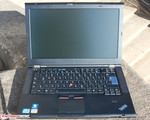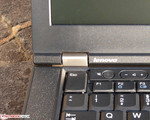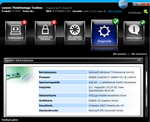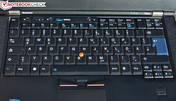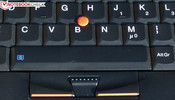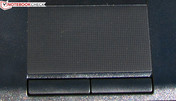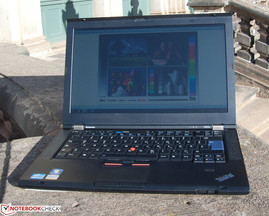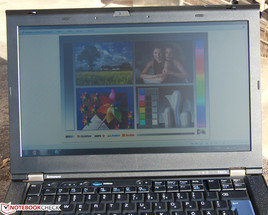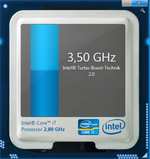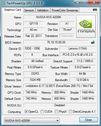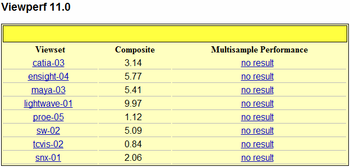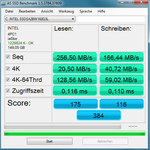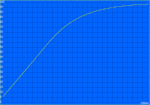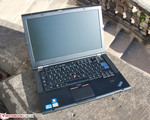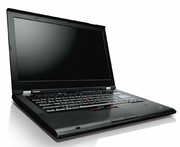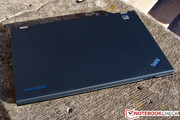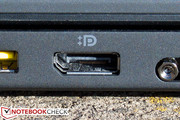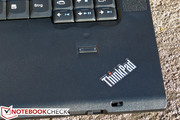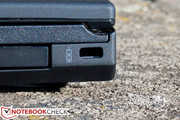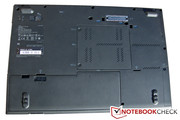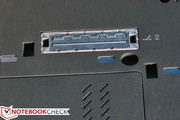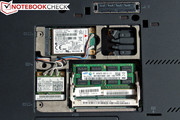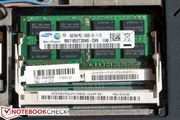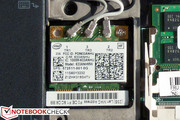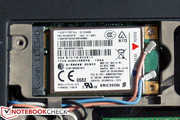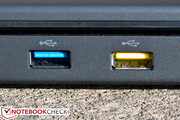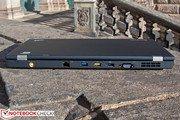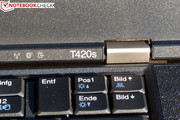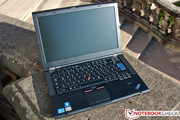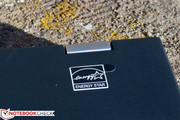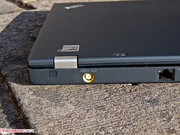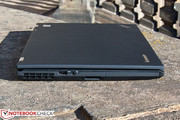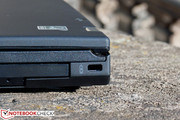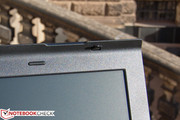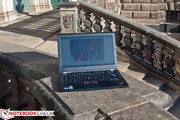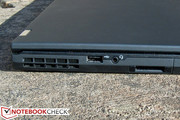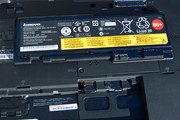Review Lenovo ThinkPad T420s 4174-PEG Notebook

Hardly another notebook range in the business sector enjoys such a high reputation as the ThinkPad models from Lenovo. The greatest robustness, high performance hardware and long battery runtimes are the qualities that let the manufacturer of the T series especially stand out.
In the following, we will examine to what extent the ThinkPad 420s can keep these promises. The T420s is a lot lighter and compacter than the previously reviewed T420 despite the same 14 inch size. However, it also has to manage with a smaller 44 Wh battery. While the immediate predecessor of the T410s still had processors from the Arrandale generation, the latest Sandy Bridge generation is now used.
Our test device has been given the name ThinkPad T420s 4174-PEG (NV8PEGE) and represents the top model of the series. Lenovo hasn't made cutbacks in configuration and installs a Core i7-2640M and a fast 160 GB SSD from Intel. The HD Graphics 3000 integrated in the processor is additionally backed by a dedicated Nvidia Quadro NVS 4200M with Optimus support. The entry level models however don't have this feature. The manufacturer only skimps in view of the memory configuration and equips the nearly 1800€ notebook with only 4 gigabytes.
The competition in the battle for the favor of financially strong corporate customers is enormous. The ThinkPad T420s has to face devices like the Dell Latitude E6420, as well as the HP EliteBook 8460p. Our comprehensive review is to clarify if Lenovo can ultimately keep the lead.
Case
The T420s looks considerably slimmer and less unwieldy than its otherwise largely identical brother, T420. This is due to a weight of about 1.7 kg and an overall height reduction of about 0.5 centimeters. Lenovo has also maintained the classic ThinkPad design in the newest scion of its notebook range. Its appearance is dominated by plain but extremely robust, black plastic, reinforced with carbon fiber and magnesium, as in the past. The manufacturing quality is almost immaculate. We couldn't find any irregular gaps or deficient material transitions.
The case only responds to very high force with marginal warping. We would only have liked to see a somewhat higher stability above the DVD drive. But the given level is exceptionally good. The torsional stiffness of the display and chassis is also impressive despite the low thickness. Regardless of all good qualities, we noticed that there is still room for improvements. The stability and quality of a MacBook Pro case, milled from aluminum, is yet unreached. That would also look good on the T420s.
The aluminum display hinges make a very high-end impression. They allow the notebook to be opened to 180 degrees. Moreover, they keep the lid in place without prolonged shaking on shaky surfaces. Nevertheless, Lenovo has accomplished pulling the hinges only so tight that the notebook can be opened and closed with one hand. The display's clamshell design, known from other ThinkPads, prevents foreign objects and dust from unintentionally penetrating the gap between the keyboard and screen. Since the display overlaps the case, damages can successfully be prevented.
Connectivity
The chassis's diet didn't go without affecting the T420s' connectivity. Only three USB ports have now found room on the case. That is two less than on the T420. In return, one of them is USB 3.0 compatible and another has an always-on function. External monitors or projectors can either be connected over VGA or DisplayPort. On the other hand, Lenovo has left out HDMI which sooner used in the private customer sector. While Gigabit LAN, a 4in1 card reader (SD/SDHC/SDXC/MMC) and a combined headphone and microphone jack are still available, the combined eSATA/USB port has been omitted in the T420s. Additional interfaces can be added via an optionally available docking station.
Only little has changed in view of interface distribution. All interfaces that are primarily needed for stationary use are found on the rear. That effectively counteracts the cable mess on the desk. Users who simply want to quickly connect a USB flash drive, a memory card or a headset can continue to do so on the device's left. Lenovo has also taken care to place all ports far enough apart so that even protruding plugs won't obstruct any neighboring interfaces.
The notebook has a 1.3 MP webcam with an average quality for video conferences. Audio is recorded via an array microphone and can convince with a clear and well-to-understand recordings. The so-called ThinkLight is a nice gadget. It's a small LED light beside the webcam that is to facilitate the T420s' use in dark surroundings.
As a business laptop, the T420s can also serve with more features: There is a Kensington Lock to protect the device against theft and the built-in fingerprint reader can be used for securing the stored data. The corresponding software is included in the preinstalled ThinkVantage tools.
Communication
The T420s almost leaves nothing to be desired in our configuration. The Intel Centrino Ultimate-N 6300 module supports all current WLAN standards up to 802.11n and also transmits in the 5 GHz network. Three antennas ensure an extremely stable connection even in cases of weak wireless signals. A Centrino Advanced-N 6250 with WiMAX support is alternately available.
Bluetooth version 3.0 takes care of data sharing with smartphones or other mobile devices in all models. Optionally available, and also installed in our test device, is a WWAN module (Ericsson F5521gw) which is capable of GPS and UMTS, including high-speed data transmission via HSPA+. The user can achieve gross data speeds of up to 21 MB/s in download and 5.76 MB/s in upload with the right rate. The SIM card slot is hidden in the battery compartment, as in the past.
Supplies
Lenovo doesn't include anything more than a quick start guide, the power adapter and the battery. Neither a driver nor a recovery CD is found. However, the user can create these from the backup partition of the T420s. Of course, all drivers and the ThinkVantage Toolbox are preinstalled in state of delivery.
Warranty
While American customers only receive a one year warranty ex-factory, all German devices have a 3 year onsite manufacturer warranty.
Input Devices
Alike the T410s or the T420, the tested T420s has the same combination of keyboard, touchpad and trackpoint. We will briefly summarize the most important qualities here.
Keyboard
The ThinkPad's keyboard bids high typing comfort, even for longer texts, with its firm and clear pressure point, its generous key drop for a laptop and the agreeably shaped keys. Yielding doesn't become evident even under high pressure at all; however the noise level could be a bit lower. The user is sufficiently compensated for this by an impression of an accurate, mechanical quality with every pressed key. The swapped position of FN and the left CRTL key may irritate the user at the beginning - a peculiarity that ThinkPads have had for years.
Trackpoint
Also unusual for a few, but a welcome tradition for the series, is the red trackpoint in the keyboard's lower center. After some getting used to, the user won't want to live without it because it allows just as a precise as fast control of the mouse cursor. Lenovo has given the trackpoint two dedicated mouse keys and a mouse wheel replacement located directly beneath the space bar. Thus, the user doesn't have to stretch his fingers up to the touchpad's keys beneath it. The click noise is very pleasant and quiet without lacking precision.
Touchpad
The touchpad's surface has a rough and distinctly different feel than the rest of the surrounding case. The finger glides pleasantly and smoothly over it and can control the mouse cursor with great accuracy. Multitouch gestures are supported, but it lessens the space on the already small touchpad gets even more. The corresponding buttons do their job quietly and reliably. However, they couldn't quite keep up with the quality of the other input devices and make a somewhat flimsy impression.
It's possible to switch between the trackpoint and the touchpad via the key combination FN+F8. Both inputs can also be used simultaneously.
Display
Lenovo uses a non-glare WXGA++ screen in all ThinkPads of the T420s range. The 16:10 format of the T410s' predecessor had to make way for a wider 16:9 aspect ratio. Consequently, the former resolution of 1440x900 has increased to 1600x900 pixels. Together with a diagonal of 14.0 inches, this results in an extremely high pixel density of 131 dpi.
Unfortunately, the screen's measured rates aren't very impressive. Despite a good and even brightness of averagely 258.7 cd/m2 in the highest setting, the contrast only equals a disappointing 154:1. The reason for this is the high black value of 1.75 cd/m2, which quickly leads to a rather grayish reproduction of black hues.
| |||||||||||||||||||||||||
Brightness Distribution: 92 %
Center on Battery: 270 cd/m²
Contrast: 154:1 (Black: 1.75 cd/m²)
46.89% AdobeRGB 1998 (Argyll 3D)
66.2% sRGB (Argyll 3D)
45.05% Display P3 (Argyll 3D)
The low viewing angle stability is also on a level that seems inappropriate for this price range. While there is at least a certain amount of leniency for the viewer on the horizontal plane, deviations of only a few degrees lead to clear image distortions vertically. Unfortunately, the T420s isn't an isolated case. Immediate opponents, such as the Dell Latitude E6420 or the HP EliteBook 8460p also have similarly poor screens.
Regardless of the partly only average results, the notebook can also be used outdoors without problems because of the matt screen surface and strong backlight. Although we would have also liked to see a screen with higher contrasts, the displayed content nevertheless remains legible even in direct sunlight.
Finally, we look at the ThinkPad's color reproduction. Both Adobe RGB and sRGB can't be covered completely, and even the larger T520 scores better here. Thus, a higher quality, external monitor should be connected over the available display port for professional image editing.
Performance
Lenovo delivers the ThinkPad T420s with Intel's second generation Core i5 and Core i7 processors. As the top model of the series, our test device is equipped with a Core i7-2640M which is currently the fastest mobile dual core CPU on the market. Thanks to SMT Technology, every core can process two threads at the same time. The processor, manufactured in a 32nm process, is based on the latest Sandy Bridge architecture and has a base clock of 2.8 GHz. It can be increased up to 3.5 GHz via Turbo Boost 2.0.
The QM67 chipset, which also supports the processor-embedded HD Graphics 3000, is on the mainboard. The manufacturer has additionally installed an Nvidia Quadro NVS 4200M in a few versions of the series. It is enabled during an operation using Optimus when needed.
Lenovo has given the T420s only one RAM module with a capacity of 4 gigabyte. Consequently, the processor also only has a single-channel memory bus available. Users, who need a larger RAM capacity and want to tickle out even the last percent of performance from the laptop, can retrofit another module in the second slot. However, the ThinkPad wasn't noticeably slowed down by the lack of dual-channel operation in our benchmarks.
The highlight of all configuration features is undoubtedly the big 160 gigabyte SSD from Intel. It promises a significant performance increase in the system benchmarks. We will examine to what extent the swift memory unit is noticeable in practical use.
CPU Performance
Thanks to the generous hardware configuration, the T420s' performance rates are convincing. We determined the processor's single thread performance with Cinebench R10. The i7-2640M only lags behind the fastest mobile CPU, the Core i7-2960XM, by about 10% with 4450/5468 points (32/64 bit). A remarkable score for a CPU with a TDP of only 35 watts, which is mainly due to the strong Turbo mode of up to 3.5 GHz. Our T420s has to admit defeat to the quad core competitors in the Multithreading Test of Cinebench R11.5: An i7-2630QM is faster by more than 50% in view of 3.12 points.
This disadvantage however only has a negative effect when highly parallel and extremely CPU-heavy applications have to be processed. Beyond that, only the Dell Latitude E6420 is available with a quad core among the immediate opponents in the 14 inch sector.
GPU Performance
The dedicated Nvidia Quadro NVS 4200M was used for our benchmarks. It is automatically enabled in graphics load thanks to Optimus Technology. Benchmarks concerning the Intel HD Graphics 3000 integrated in the processor can be found in our database. The NVS 4200M is based on the GF119 chip, manufactured in a 40 nanometer process, and is also embedded on the entry level card, GeForce GT 520M. It has 48 shader ALUs and supports the current DirectX 11 standard. Lenovo has given the graphics chip a 1 gigabyte DDR3 memory on a 64bit wide memory interface; the clock speed is 740/1480/800 MHz (core/shader/memory). This is a bit lower than the manufacturers specification of 810/1620/800 MHz, which results in a performance loss of about 10%.
As expected, the card places itself approximately on the level of the identically clocked GeForce GT 520M and reaches 4829 points in 3DMark06. We could determine 2298 points in the performance preset with the successor, 3DMark Vantage.
| 3DMark 05 Standard | 9388 points | |
| 3DMark 06 Standard Score | 4829 points | |
| 3DMark Vantage P Result | 2298 points | |
| 3DMark 11 Performance | 572 points | |
Help | ||
Gaming Performance
Is this enough to also render newer games smoothly? The answer is a clear "yes and no". The demo version of newly released-building strategy game Anno 2070, used in the test, was only smoothly displayed in 1024x768 pixels and low details with 47.7 fps. Thus, the NVS 4200M is only slightly faster than the Core i7-2640M's embedded graphics chip in this case. We could select medium or high details in older or less demanding games, like Fifa 12, but gamers won't be satisfied with the T420s' graphics performance.
| low | med. | high | ultra | |
|---|---|---|---|---|
| Anno 2070 (2011) | 47.7 | 17.6 | 11.7 |
CAD Performance
This shortcoming won't likely be as devastating for the target group. Although the Quadro products are based on the same GeForce GPUs from Nvidia, these cards are specifically optimized for professional applications, such as from the CAD field. The low raw performance in the case of the NVS 4200M can only be compensated to an extent as can be seen in our very demanding benchmark, SPECviewperf 11.
System Performance
The T420s achieves extremely good results in the system benchmark, PCMark, thanks to the fast processor and the SSD hard disk. With a total score of 11911 points in the Vantage version, the HP EliteBook 8460p (7734 points) can be surpassed by 54%. 3312 points in PCMark 7 is also a very strong score. Even some gaming notebooks, like the Samsung 700G7A, don't manage that. Only larger laptops with a quad core processor and a high-end GPU can achieve better results here.
| PCMark Vantage Result | 11911 points | |
| PCMark 7 Score | 3312 points | |
Help | ||
Mass Memory
In contrast to the entry level versions, our T420s test model comes with a 160 GB Intel SSD 320 series. The drive delivers an excellent presentation with sequential transfer rates of 275.9 MB/s in read and 173.2 MB/s in write (CrystalDiskMark 3.0). It can also excel with SSD-typical access speeds of 0.116/0.110 milliseconds (read/write). Now even faster drives with a SATA III interface are on the market. However, the solid state drives from Intel are deemed to be particularly reliable and are therefore an appropriate choice for the business laptop.
Lenovo has branched off almost 16 gigabyte from the total capacity of 160 gigabyte for the recovery partition. The remainder is available for the operating system and other applications on a shared drive. The data memory's speed is already impressing when the preinstalled Windows 7 Professional as the 64bit version is booted: The system is ready for use in less than 30 seconds after pressing the power button. Program installations and starts are accelerated significantly compared with a conventional hard disk. Moreover, no noise is generated and it has a lower power consumption. The user however has to accept a smaller capacity and a higher price in return.
Emissions
System Noise
ThinkPad users have high demands in an escort for everyday business regarding the noise of their work device. The fan of the T420s is usually deactivated in idle and light office tasks. Consequently, the notebook works absolutely noiselessly thanks to the SSD drive. Unfortunately, this condition doesn't last very long when the hardware is loaded a bit more, for example by a flash video. Despite uncritical temperature rates, the fan is turned on after a few seconds. It rotates fairly quietly and consistently, but it hums along audibly anyway.
On the other hand, the ThinkPad is mostly unobtrusive during full load. We couldn't measure more than 36.6 dB (A) even during our stress test with Furmark and Prime95 - a very good rate. Up until now, hardly a comparable device remained similarly quiet during this load. Even the Dell Latitude E6420 with a weaker Core i3-2310M climbed up to 42.9 dB (A).
Noise level
| Idle |
| 33.7 / 33.7 / 34.2 dB(A) |
| DVD |
| 36.2 / 44 dB(A) |
| Load |
| 34.2 / 36.6 dB(A) |
 | ||
30 dB silent 40 dB(A) audible 50 dB(A) loud |
||
min: | ||
Temperature
The temperatures of case and hardware reflect the result of our noise measurements. We could measure temperatures of only 22-27°C without load. The notebook hardly gets lukewarm even directly at the vent.
The case temperatures increase clearly after longer hardware load induced by our stress test and reach up to 39°C on the top. The cooling system can however keep a pleasant 28°C upright in the wrist rest and touchpad area. The bottom heats up to a very high 51°C selectively, but remains on a acceptable level on average.
The maximum temperature of up to 99°C on the GPU and 96°C on the CPU is bordering. However, no stability issues developed in our multi-hour stress test and the processor only throttled marginally from 2.8 GHz to 2.5 GHz. The processor and graphics card remained a lot cooler in a realistic load induced by Cinebench or Anno 2070. Consequently, the device's cooling capacity should also be suitable for a warm summer.
(+) The maximum temperature on the upper side is 39.3 °C / 103 F, compared to the average of 34.3 °C / 94 F, ranging from 21.2 to 62.5 °C for the class Office.
(-) The bottom heats up to a maximum of 51 °C / 124 F, compared to the average of 36.8 °C / 98 F
(+) In idle usage, the average temperature for the upper side is 25 °C / 77 F, compared to the device average of 29.5 °C / 85 F.
(+) The palmrests and touchpad are cooler than skin temperature with a maximum of 28.4 °C / 83.1 F and are therefore cool to the touch.
(±) The average temperature of the palmrest area of similar devices was 27.6 °C / 81.7 F (-0.8 °C / -1.4 F).
Speakers
The T420s has two small stereo speakers, which are hidden behind a lattice on the keyboard's left and right. Not much has changed in regards to the mediocre sound quality of other ThinkPad range models. Midranges could already only be played insufficiently from the small speakers, and we didn't notice any basses. Speech is rendered somewhat tinny, but intelligibly and without distortions providing the user doesn't exceed a low volume. Otherwise it is advisable to connect an additional sound system using the headphone out, which succeeded with good quality in the test.
Battery Life
Power Consumption
The ThinkPad T420s' power consumption isn't conspicuous. 10 to 16 watts in idle aren't a record for a laptop with Optimus support, but are within an acceptable limit. The power requirement clearly increases in full load. We could measure a maximum of 64.5 watts in the unrealistic stress test with Prime95 and Furmark. In view of the installed hardware and the only marginal throttling, it's a good rate. The Dell Latitude 6420, which was even more energy efficient in idle, consumed a bit more despite a weaker processor in this case (67.3 watts).
The included 90 watt power adapter has a sufficient capacity to charge the battery even during load.
| Off / Standby | |
| Idle | |
| Load |
|
Key:
min: | |
The 6 cell battery now only has a capacity of 44 Wh due to the T420s' slim case, while the T420 had 57 Wh. The laptop managed a battery runtime of over 6 hours in the Battery Eater Reader's test, which simulates the notebook's idle mode in minimum brightness. So about 2 hours more than the previous T410s. Surfing via WLAN also proves that the new Sandy Bridge range is more energy efficient than the former Arrandale processor with a battery life of almost 4 hours. The T420s can't hide its powerful hardware and had to give up after 42 minutes in load.
Verdict
Lenovo hasn't really launched a new product onto the market with the T420s. No matter if it's the classic ThinkPad case design, the excellent input devices or the installed hardware, we have seen almost all of these model characteristics in the sister model, T420, or the previous T410s.
Nevertheless, the T420s occupies a market niche that is supposed to especially address business customers with its combination of high performance components and high mobility. They will likely be pleased about a fast Core i7, an SSD drive and an extensive connectivity including UMTS/HSPA at a price of just under 1800€. The manufacturing quality and case stability is high-end, but is surpassed by a few competitors, such as the HP EliteBook 8460p.
We noticed room for improvement in the fan management's fine-tuning and the built-in screen. The latter is suitable for outdoor use due to its matt surface and good brightness, but is very viewing angle dependent and has a disappointing black value.
Overall, the Lenovo ThinkPad T420s earns itself a good, though not very good total score of 84%. In addition to the EliteBook 8460p from HP, the Dell Latitude E6420 could be a possible alternative. It can achieve a battery life of up to 12 hours due to an optional 9 cell battery.




